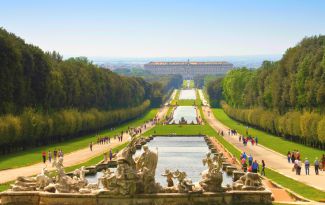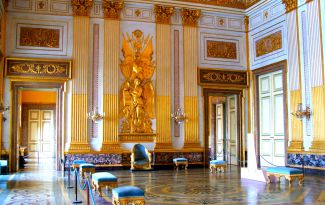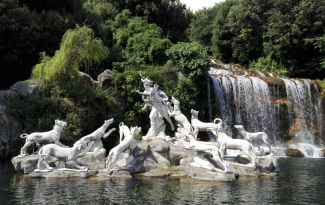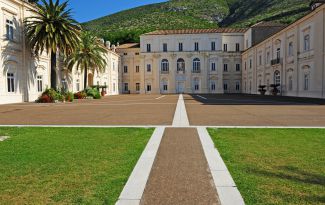The Golden Age
The Royal Palace of CasertaThe Royal Palace of Caserta is an extraordinary and unique heritage. Each visit to this palace leaves you amazed time and time again. The complex was designed by Luigi Vanvitelli, the apartments are adorned with stucco work, sculptures, engravings, and furniture from France. The paintings on the walls are the work of Italian and Dutch painters from the 19th century, depicting the Borgone family. In the basement of this palace, you can find drawings, designs, and illustrations of the architect Vanvitelli's work. Don't miss the Royal Garden with its numerous sculptures, fountains, and rare exotic plants.
Currently, the palace is also used as a center for contemporary art, and the 'Terrae Motus' collection is presented. The works of the artists are located in the apartments' rooms. Therefore, Don't be surprised when you cross the baroque apartments and suddenly stumble upon an installation.
Currently, the palace is also used as a center for contemporary art, and the 'Terrae Motus' collection is presented. The works of the artists are located in the apartments' rooms. Therefore, Don't be surprised when you cross the baroque apartments and suddenly stumble upon an installation.
Silk Factory of San Leucio – A Successful Social Experiment
In 1750 the possessions of the Aquaviva di Caserta were passed on to the Bourbons of Naples. Not long after, San Leucio became the center for Royal silk. King Charles of Bourbon, on the advice of the minister Bernardo Tanucci, initiated an exchange with France to bring the art of weaving to Italy. Later, this technique would be applied in factories.
In 1789, the architect Francis Collecini formed a community known as "the Royal Colony of San Leucio". Local workers and even french craftsmen from Genoa, Piedmont, and Messina who settled in San Leucio enjoyed the many benefits that silk factory workers had. Workers not only received a house in the colony, but their family members received free education too. The king established the first school in Italy here, offering both male and female disciplines. The number of working hours in San Leucio was eleven instead of the common fourteen hours as in the rest of Europe.
Also, the houses were designed following all the design rules of the time and were equipped with toilets and irrigation from the beginning. The king offered a dowry to women, and there was a so-called 'pot of love' to which everyone had to donate a portion of their earnings.
There was no distinction between different individuals, regardless of their work. Men and women enjoyed equality within a system primarily based on meritocracy. Private land ownership was not allowed, and there was a guarantee of care for the elderly and weaker individuals, fostering a strengthened sense of brotherhood. It was a social experiment. In the era of the "Enlightenment," this model of justice and social equality was very rare in 18th-century Europe. This model was adhered to during the subsequent French Revolution and Marxism.
In 1789, the architect Francis Collecini formed a community known as "the Royal Colony of San Leucio". Local workers and even french craftsmen from Genoa, Piedmont, and Messina who settled in San Leucio enjoyed the many benefits that silk factory workers had. Workers not only received a house in the colony, but their family members received free education too. The king established the first school in Italy here, offering both male and female disciplines. The number of working hours in San Leucio was eleven instead of the common fourteen hours as in the rest of Europe.
Also, the houses were designed following all the design rules of the time and were equipped with toilets and irrigation from the beginning. The king offered a dowry to women, and there was a so-called 'pot of love' to which everyone had to donate a portion of their earnings.
There was no distinction between different individuals, regardless of their work. Men and women enjoyed equality within a system primarily based on meritocracy. Private land ownership was not allowed, and there was a guarantee of care for the elderly and weaker individuals, fostering a strengthened sense of brotherhood. It was a social experiment. In the era of the "Enlightenment," this model of justice and social equality was very rare in 18th-century Europe. This model was adhered to during the subsequent French Revolution and Marxism.
Caserta Vecchia (Old Caserta)
Caserta Vecchia is a splendid jewel at an altitude of 450 meters and less than 10 km away from Caserta. The old village is like a national monument due to its art and history.
In Caserta Vecchia, one can go for walks or have picnics in the summer, for instance. The old village offers a picturesque view of the Bay of Naples, and there are many restaurants in the first week of September that enliven "September in the village." Visitors who come here are surprised by their sudden interest in the old village. Since the sixteenth century, this village has retained its charming and interesting appearance of a medieval village. Near the diocese square is the Cathedral, an exceptional example of Arab-Norman architecture.
Accommodations in this area:

La Pampa Relais - Caserta

Tenuta Pezzapane – Alvignanello








